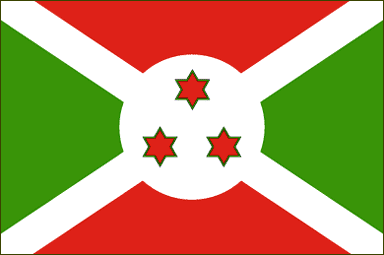Burundi

|
|
|
|
GEOGRAPHICAL LOCATION |
|
| Area |
27.834 km² including 25.834 km² land area |
|
Climate and altitude |
Equatorial climate, high highlands with significant differences in altitude (from 772 to 2'670 meters). The average annual temperature ranges from 17 to 23 degrees Celsius. |
|
Relief and altitude |
Hills and mountains, some plains to the east. The national territory culminates at the highest point at 2670m at Mount Heha and Lake Tanganyika is the lowest point at an altitude of 772m. |
|
Hydrography |
The main rivers: Ruzizi, Malagarasi and Ruvubu. |
|
SOCIO-ECONOMIC SITUATION |
|
|
Population |
8.053.574 Residents (ISTEEBU, 2008) |
|
Average population density |
289hab./km² |
|
Ratio of urban to rural population |
10/90 |
|
Major Cities |
Bujumbura (497.166hab.), Gitega (41.944hab.), Ngozi (42.835hab.; ISTEEBU, 2008) |
|
GDP / capita |
267$US/hab. (World Bank, 2013) |
|
Human Development Index (HDI) |
0,389; 180/187 pays (UNDP, 2014) |
|
Major economic activities |
Agriculture |
|
FLORISTIC POTENTIAL |
|
|
Low forest cover in the order of 13% of the total land area. |
|
|
Area of natural or little anthropogenic vegetation |
22.000km2(Ernst et al., 2012) |
|
Area of natural or little anthropogenic forests |
1000km² (Ernst et al., 2012) |
|
Phanerogams |
2.947 species, 20 endemic (MEEATU, 2013), 7 threatened plant species (UICN, 2014) |
|
cryptogames |
246 species (MEEATU, 2013) |
|
Champignons |
110 species (INECN, 2013) |
|
Mammifères |
143 species, 17 endémics (MEEATU, 2013), 11 threatened species (UICN, 2014) |
|
WILDLIFE POTENTIAL AND PROTECTED AREAS |
|
|
Birds |
722 species, 23 endémics (MEEATU, 2013), 13 threatened species (UICN, 2014) |
|
Reptiles |
115 species (MEEATU, 2013), 0 threatened specie (UICN, 2014) |
|
amphibians |
69 species (MEEATU, 2013), 5 threatened species (UICN, 2014) |
|
fish |
270 species, 201 endémics (MEEATU, 2013), 17 threatened species (UICN, 2014) |
|
Other animal groups |
Data not available |
|
Protected Areas |
16 protected areas covering just over 143,000 ha, which is 5.1% of the total national territory and almost 30% of the total available natural ecosystems (MEEATU, 2013). |
|
CLIMATE CHANGE AND REDD+ |
|
|
Burundi is highly vulnerable to natural hazards and disasters associated with climate change.
VISION: "A State that promotes development that is resilient to the adverse effects of climate change". |
Preparation for the publication of the first and second national communications under the UNFCCC National Adaptation Plan (NAPA) published in 2007. A National Strategy for Adaptation to Climate Change and Action Plan were developed in 2013. Burundi does not have a specific REDD strategy or a low-carbon development plan. At the beginning of Phase 1. Ongoing request for funding for the preparation of the R-PIN addressed to UN REDD and FCPF (no action for the moment). No official REDD policy document Translated with www.DeepL.com/Translator (free version) |
|
The wonders of Lake Tanganyika |
|

